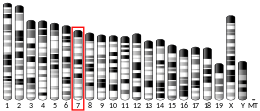Concentrative nucleoside transporter 1
Concentrative nucleoside transporter 1 (CNT1) is a protein that in humans is encoded by the SLC28A1 gene.[5][6]
References
- GRCh38: Ensembl release 89: ENSG00000156222 - Ensembl, May 2017
- GRCm38: Ensembl release 89: ENSMUSG00000025726 - Ensembl, May 2017
- "Human PubMed Reference:". National Center for Biotechnology Information, U.S. National Library of Medicine.
- "Mouse PubMed Reference:". National Center for Biotechnology Information, U.S. National Library of Medicine.
- Ritzel MW, Yao SY, Huang MY, Elliott JF, Cass CE, Young JD (Apr 1997). "Molecular cloning and functional expression of cDNAs encoding a human Na+-nucleoside cotransporter (hCNT1)". Am J Physiol. 272 (2 Pt 1): C707–14. doi:10.1152/ajpcell.1997.272.2.C707. PMID 9124315.
- "Entrez Gene: SLC28A1 solute carrier family 28 (sodium-coupled nucleoside transporter), member 1".
Further reading
- Ritzel MW, Ng AM, Yao SY, et al. (2001). "Recent molecular advances in studies of the concentrative Na+-dependent nucleoside transporter (CNT) family: identification and characterization of novel human and mouse proteins (hCNT3 and mCNT3) broadly selective for purine and pyrimidine nucleosides (system cib)". Mol. Membr. Biol. 18 (1): 65–72. doi:10.1080/09687680118530. PMID 11396613.
- Ritzel MW, Yao SY, Ng AM, et al. (1999). "Molecular cloning, functional expression and chromosomal localization of a cDNA encoding a human Na+/nucleoside cotransporter (hCNT2) selective for purine nucleosides and uridine". Mol. Membr. Biol. 15 (4): 203–11. doi:10.3109/09687689709044322. PMID 10087507.
- Loewen SK, Ng AM, Yao SY, et al. (1999). "Identification of amino acid residues responsible for the pyrimidine and purine nucleoside specificities of human concentrative Na(+) nucleoside cotransporters hCNT1 and hCNT2". J. Biol. Chem. 274 (35): 24475–84. doi:10.1074/jbc.274.35.24475. PMID 10455109.
- Mata JF, García-Manteiga JM, Lostao MP, et al. (2001). "Role of the human concentrative nucleoside transporter (hCNT1) in the cytotoxic action of 5[Prime]-deoxy-5-fluorouridine, an active intermediate metabolite of capecitabine, a novel oral anticancer drug". Mol. Pharmacol. 59 (6): 1542–8. doi:10.1124/mol.59.6.1542. hdl:10171/21116. PMID 11353816.
- Lai Y, Bakken AH, Unadkat JD (2002). "Simultaneous expression of hCNT1-CFP and hENT1-YFP in Madin-Darby canine kidney cells. Localization and vectorial transport studies". J. Biol. Chem. 277 (40): 37711–7. doi:10.1074/jbc.M204986200. PMID 12097333.
- Alcorn J, Lu X, Moscow JA, McNamara PJ (2002). "Transporter gene expression in lactating and nonlactating human mammary epithelial cells using real-time reverse transcription-polymerase chain reaction". J. Pharmacol. Exp. Ther. 303 (2): 487–96. doi:10.1124/jpet.102.038315. PMID 12388627.
- Molina-Arcas M, Bellosillo B, Casado FJ, et al. (2003). "Fludarabine uptake mechanisms in B-cell chronic lymphocytic leukemia". Blood. 101 (6): 2328–34. doi:10.1182/blood-2002-07-2236. PMID 12411296.
- Strausberg RL, Feingold EA, Grouse LH, et al. (2003). "Generation and initial analysis of more than 15,000 full-length human and mouse cDNA sequences". Proc. Natl. Acad. Sci. U.S.A. 99 (26): 16899–903. doi:10.1073/pnas.242603899. PMC 139241. PMID 12477932.
- García-Manteiga J, Molina-Arcas M, Casado FJ, et al. (2004). "Nucleoside transporter profiles in human pancreatic cancer cells: role of hCNT1 in 2',2'-difluorodeoxycytidine- induced cytotoxicity". Clin. Cancer Res. 9 (13): 5000–8. PMID 14581375.
- Loewen SK, Yao SY, Slugoski MD, et al. (2004). "Transport of physiological nucleosides and anti-viral and anti-neoplastic nucleoside drugs by recombinant Escherichia coli nucleoside-H(+) cotransporter (NupC) produced in Xenopus laevis oocytes". Mol. Membr. Biol. 21 (1): 1–10. doi:10.1080/0968768031000140836. PMID 14668133.
- Gray JH, Mangravite LM, Owen RP, et al. (2004). "Functional and genetic diversity in the concentrative nucleoside transporter, CNT1, in human populations". Mol. Pharmacol. 65 (3): 512–9. doi:10.1124/mol.65.3.512. PMID 14978229.
- Farré X, Guillén-Gómez E, Sánchez L, et al. (2004). "Expression of the nucleoside-derived drug transporters hCNT1, hENT1 and hENT2 in gynecologic tumors". Int. J. Cancer. 112 (6): 959–66. doi:10.1002/ijc.20524. PMID 15386342.
- Lai Y, Lee EW, Ton CC, et al. (2005). "Conserved residues F316 and G476 in the concentrative nucleoside transporter 1 (hCNT1) affect guanosine sensitivity and membrane expression, respectively". Am. J. Physiol., Cell Physiol. 288 (1): C39–45. doi:10.1152/ajpcell.00192.2004. PMID 15456697. S2CID 27633580.
- Fernández-Veledo S, Jover R, Casado FJ, et al. (2007). "Transcription factors involved in the expression of SLC28 genes in human liver parenchymal cells". Biochem. Biophys. Res. Commun. 353 (2): 381–8. doi:10.1016/j.bbrc.2006.12.021. PMID 17187757.
- Slugoski MD, Loewen SK, Ng AM, et al. (2007). "Specific mutations in transmembrane helix 8 of human concentrative Na+/nucleoside cotransporter hCNT1 affect permeant selectivity and cation coupling". Biochemistry. 46 (6): 1684–93. doi:10.1021/bi061692s. PMID 17279631.
- Smith KM, Slugoski MD, Cass CE, et al. (2007). "Cation coupling properties of human concentrative nucleoside transporters hCNT1, hCNT2 and hCNT3". Mol. Membr. Biol. 24 (1): 53–64. doi:10.1080/09687860600942534. PMID 17453413.
- Guallar JP, Cano-Soldado P, Aymerich I, et al. (2007). "Altered expression of nucleoside transporter genes (SLC28 and SLC29) in adipose tissue from HIV-1-infected patients". Antivir. Ther. (Lond.). 12 (6): 853–63. PMID 17926640.
This article is issued from Wikipedia. The text is licensed under Creative Commons - Attribution - Sharealike. Additional terms may apply for the media files.



